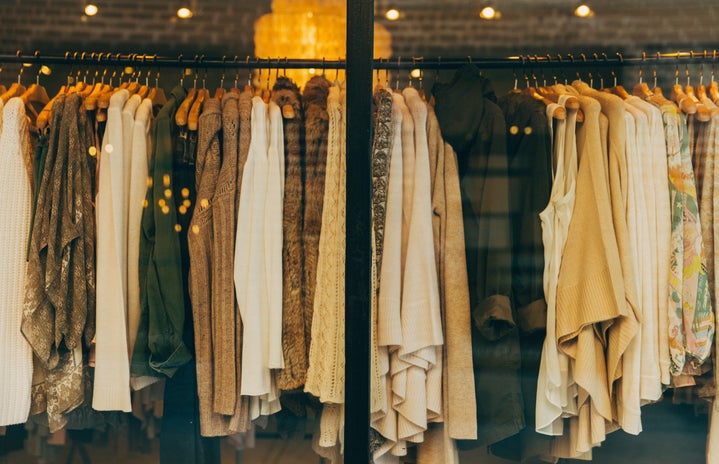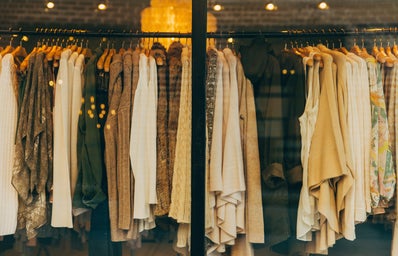As humans, we dress as much as we breathe. In fact, I think about my clothes at least three times a day. I think about what I’ve worn, what I’m currently wearing, and what I’ll wear tomorrow. I even imagine what I’d wear on the red carpet even though I am nowhere near celebrity status.
Clothing is such an impactful part of my identity, which leads me to a single question — why?
I am a Canadian-born Indian woman and a second-generation immigrant. Like all children who lacked motor skills from ages one to three, I was dressed head-to-toe by my parents. They dictated the clothes in my closet and my outfit for a particular day or occasion. In other words, I first learned about clothing through my parents’ dressing practices. But their decisions weren’t spur of the moment. Rather, they were influenced by their experiences as Indian people in Canada.
My parents moved to Canada with their respective families in the 1980s at nine-years-old. Unfortunately, this was an unwelcoming period for immigrants. My mother and father both experienced oppression and discrimination of the highest forms. Their adolescence was undoubtedly negatively impactful both on their present and future bodies. As a result, my brother and I bore the cultural aftermath of our parents’ experiences.
I had the pleasure of speaking with my parents about their experiences dressing me, in which these ideas about generational trauma emerged.
“I went to a school that was pretty affluent. People wore Polo shirts and loafers, and Calvin Klein. I wanted all those things but couldn’t,” my mother recalled. “I think that’s why we bought the best of everything for you.”
It was at this moment that a light bulb went off inside my head. What if, I thought, my dressing practices now are merely an extension of these ideas? As a diasporic child, uncovering the reasons why I dress the way I do is just as important as identifying my ancestral history. So, let’s do that together with distinctive pieces of my wardrobe.
Little Mermaid Nightgown

How adorable is this nightgown! Growing up, my favourite movie was The Little Mermaid. There was something about the way Ariel sang (and the way Prince Eric looked) that made my four-year-old heart swoon. I made my parents watch this film probably five times a month, and, rather than complaining about my obsession, they bought me this gorgeous nightgown at the Disney store circa 2006.
The material is listed as polyester but feels like satin, and I wore it to death. The two straps at the back are literally hanging on by a thread. Still, I just can’t part with it. At first glance, I would say this nightgown makes me nostalgic, but, with my mother’s voice in my head (“We bought the best of everything for you”), this nostalgia turns into concern.
The control my parents had over the way I dressed makes me wonder what experiences informed their shopping habits. Arcadia says dressing your child revolves around six simple considerations: comfort, colour, fabric, patterns, taste, and occasion. But I think they left one out: assimilation.
Dressing your child is a critical task. It not only makes them presentable to society but allows the parent to control how they want their child to be perceived — it’s the basis of material identity. This nightgown was bought to do that specifically. To me, it says that I’m cultured by watching Disney films, and I am middle-class because of its origins. In other words, it allows me to fit in — something my parents were denied when they grew up.
When asked about whether they considered my identity when dressing me, my parents admitted they didn’t want me to “look too Indian” and “didn’t want [me] to be singled out” much in the way they were around my age.
What a heartbreaking conclusion to come to as a 21-year-old that the basis of my identity is rooted in the traumatic experiences of my parents. The same people who held my hand while crossing the street, the people who scoop me up in bear hugs when we reunite, and the people who tell me at least once a day that they love me. How is it that my self-expression is rooted in their pain? It doesn’t feel fair because it isn’t.
Cropped Black Sweater

Let’s fast forward approximately 10 years. I’m 14 years old, a freshman in high school, and just starting to break out of my shell. I no longer rely on my parents to dress me, but in many ways, they still have control over what I do and do not wear. Plus, my high school had a nasty dress code that I was always too scared to challenge — until I found this sweater.
My high school experience was just as monotonous as I’m sure a lot of people’s were. I was one of five brown girls in my grade, and though I loved standing out, this caused a lot of self-sabotage. I constantly compared myself to other girls in my grade and always wanted what they had. Having gone through the same thing, my mother tried hard not to let this happen, but there was no preventing it.
In 2016, cropped sweaters such as the one pictured were everywhere. To my mother’s eyes, this sweater was nothing but a piece of fabric. To me, this was my moment of rebellion. I bought it at Marshall’s with my own money and wore it at least once a week from then on. The first time I wore it to school, I paired it with a black tank underneath to avoid getting dress-coded by my teachers. A few weeks into winter, I started to get a bit riskier. I would wear a tank top underneath and take it off in the tiny bathroom stall when I got to school (if you’re reading this, sorry, Mom).
The virality of cropped sweaters was alluring to me. My closest friends wore them, the popular girls wore them, and even celebrities like Kylie Jenner wore them. They were a sign of status and worth. I wanted to be seen in the exact same way.
When The Rosenrot wrote, “Consumption is now usurped as a foundation for identity,” they conveyed how important investing in clothing can be to explorers of self-expression.
Though I think my search for validation was rooted in self-consciousness, I was also trying to find myself within consumption ideologies.
The Rosenrot continued, saying that “The act of purchasing [and] using […] becomes a source of pride to cover our personal insecurities, childhood traumas and loneliness.”
This sweater was my source of happiness, of acceptance, of overcoming feelings of unworthiness. It was by buying and wearing it that I felt closer to the Western version of myself that I wanted to be.
There is a clear, direct ripple effect between my parents’ experiences, how they dressed me as a child, and how I began to dress myself as a teenager. The generational trauma experienced and the desperate search for assimilation is not merely a product of the pain my parents endured. It is a direct reflection of the systems built that fail to include immigrants and children of immigrants within ideological conventions and conversations about fashion.
Upcycled V-Neck Top

Almost eight years later, my closet (and my life) has completely changed. I no longer live with my parents, and because of this, my integration into the real world is made much more severe. A way that I can harness control over the chaos of adulthood is through what I wear.
I thrifted this top on a hot summer day last year. Before it looked the way it does now, the top was much more square and long, which didn’t reflect my style at all. So, I took it upon myself to turn the top into something I identify with. I hemmed the shirt, took in the sides, washed it, and voila! It’s basically a brand-new top!
I come from a line of tailors. In fact, my great-grandfather was a tailor in 1940s Kenya, and when I was 10 or 11 years old, my Naniji (grandmother) taught me how to thread and use a sewing machine. Since then, I’ve made skirts, tops, and even mermaid tail blankets (don’t ask). In the summer, I’m an upcycling fiend. I rid my desk of the books and pens and filled it with pins and thread instead.
Sewing is a way for me to be creative and enact control. It also lets me connect with my tailor ancestors. That is why dressing, to me, is much more than not being naked. It’s about deciding who I want to be and how I want to influence those before and after me.
With each generation, diasporic families continue to weaken the grasp trauma has on us. We begin to deconstruct the institutional and cultural deficiencies of the West that position us as other. I strongly believe that fashion is a way for us to do that. We must begin to question why we choose to wear what we do and where our style comes from. It is through this that we can understand and challenge the power that is inflicted on diasporic children to submit to Western culture.
In my case, I started by wearing what my parents bought for me, then began rebelling against parental expectations by seeking trendy items, and finally started inserting my hands into the creative making/dressing process. But am I still seeking that assimilation my parents and I so clearly craved ever since I was a child? My answer is that I don’t think it necessarily leaves. But I’ll be damned if I don’t try to overcome it.


